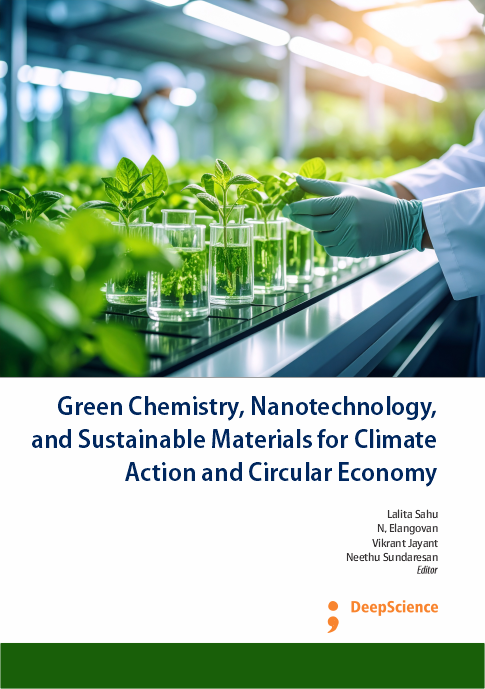Green Chemistry, Nanotechnology, and Sustainable Materials for Climate Action and Circular Economy
Keywords:
Green Chemistry, Nanotechnology, Sustainability, Climate Change, Circular Economy, Photocatalysis, Water PurificationSynopsis
The rapid pace of technological and industrial advancement has brought tremendous benefits to society, yet it has also generated pressing environmental challenges. Issues such as plastic pollution, resource depletion, and climate change highlight the urgent need for innovative materials and sustainable solutions. Against this backdrop, Green Materials and Sustainable Applications has been conceived as a collective effort to showcase the latest developments, methodologies, and applications of environmentally friendly materials and technologies.
This volume brings together interdisciplinary contributions from researchers and practitioners working across key domains of sustainable materials science, including nanomaterials, biopolymers, photocatalysts, thermodynamic modeling, biomass valorization, and green composites. Each chapter not only explores the scientific principles underlying these technologies but also emphasizes their practical and societal implications, particularly in reducing environmental impact, enhancing material efficiency, and supporting the global shift toward a circular economy.
Chapters
-
A Review on the Role of Green Chemistry in Sustainable Development
-
Impact of Climate Change on Atmospheric Chemistry: A Review of Mechanistic Pathways
-
Computational Analysis of Molecular Orbitals using DFT: A Theoretical Study
-
Thermodynamic Modeling of Phase Equilibria in Multicomponent Systems
-
Green Catalysis in Organic Synthesis: Eco-Friendly Alternatives to Conventional Methods
-
Nanostructured Materials for Sustainable Water Purification Systems
-
Development of Biodegradable Polymers Using Green Nanotechnology
-
Photocatalytic Nanomaterials for Clean Energy Applications
-
Green Chemistry Principles and Industrial Applications: A Pathway to Sustainable Development
-
Valorization of Agricultural Waste into High-Value Chemical Products
-
Vector Control Challenges in Forest-Rural Settings: A Case Study from Gariyaband District, India
-
Biodiversity Conservation and Ecosystem Restoration: Integrating Science and Policy Perspectives
-
Meta-Analysis of Global Water Contaminants and Chemical Treatment Techniques
-
From Green Chemistry to Sustainable Citizenship: Transformative Teaching Approaches
-
Sustainable Agriculture and Food Security: Balancing Productivity, Environmental Conservation, and Human Health
-
Comparative Analysis of Natural and Synthetic Polymers
References
Abdussalam-Mohammed, W., Ali, A., & Errayes, A. (2020). Green chemistry: principles, applications, and disadvantages. Chemical Methodologies, 4(4), 408–423. https://doi.org/10.33945/SAMI/CHEMM.2020.4.4
Ardila‐Fierro, K. J., & Hernández, J. G. (2021). Sustainability assessment of mechanochemistry by using the twelve principles of green chemistry. ChemSusChem, 14(10), 2145–2162. https://doi.org/10.1002/cssc.202100478
Chen, T.-L., Kim, H., Pan, S.-Y., Tseng, P.-C., Lin, Y.-P., & Chiang, P.-C. (2020). Implementation of green chemistry principles in circular economy system towards sustainable development goals: Challenges and perspectives. Science of The Total Environment, 716, 136998. https://doi.org/10.1016/j.scitotenv.2020.136998
de Marco, B. A., Rechelo, B. S., Tótoli, E. G., Kogawa, A. C., & Salgado, H. R. N. (2019). Evolution of green chemistry and its multidimensional impacts: A review. Saudi Pharmaceutical Journal, 27(1), 1–8. https://doi.org/https://doi.org/10.1016/j.jsps.2018.07.011
Ganesh, K. N., Zhang, D., Miller, S. J., Rossen, K., Chirik, P. J., Kozlowski, M. C., Zimmerman, J. B., Brooks, B. W., Savage, P. E., Allen, D. T., & Voutchkova-Kostal, A. M. (2021). Green chemistry: a framework for a sustainable future. ACS Publications, 6(25), 16254–16258. https://doi.org/10.1021/acsomega.1c03011
Kurul, F., Doruk, B., & Topkaya, S. N. (2025). Principles of green chemistry: building a sustainable future. Discover Chemistry, 2. https://doi.org/10.1007/s44371-025-00152-9
Lancaster, M. (2025). Green chemistry: an introductory text. In books.google.com. Publisher. https://books.google.com/books?hl=en&lr=&id=bGE1EQAAQBAJ&oi=fnd&pg=PT14&dq=green+chemistry+contributions+to+sustainable+development&ots=D-ojazeYNr&sig=ARL--Sfw6OIRa7r-gIdtyZzJaAA
Loste, N., Roldán, E., Lomba, L., & Giner, B. (2019). Green chemistry and environmental management systems: relationships, synergies, advantages and barriers of joint implementation at universities. Environmental Management, 64, 783–793. https://doi.org/10.1007/s00267-019-01218-y
Ogodo, U. P., & Abosede, O. O. (2025). The role of chemistry in achieving sustainable development goals: Green chemistry perspective. International Research Journal of Pure and Applied Chemistry, 26(1), 1–8. https://doi.org/https://doi.org/10.9734/irjpac/2025/v26i1893
Ratti, R. (2020). Industrial applications of green chemistry: Status, Challenges and Prospects. SN Applied Sciences, 2, 263. https://doi.org/10.1007/s42452-020-2019-6
Rogers, L., & Jensen, K. F. (2019). Continuous manufacturing–the Green Chemistry promise? Green Chemistry (RSC Publishing), 21, 3481–3498. https://doi.org/10.1039/C9GC00773C
Rosa, R., Pini, M., Cappucci, G. M., & Ferrari, A. M. (2022). Principles and indicators for assessing the environmental dimension of sustainability within green and sustainable chemistry. Current Opinion in Green and Sustainable Chemistry, 37, 100654. https://doi.org/10.1016/j.cogsc.2022.100654














